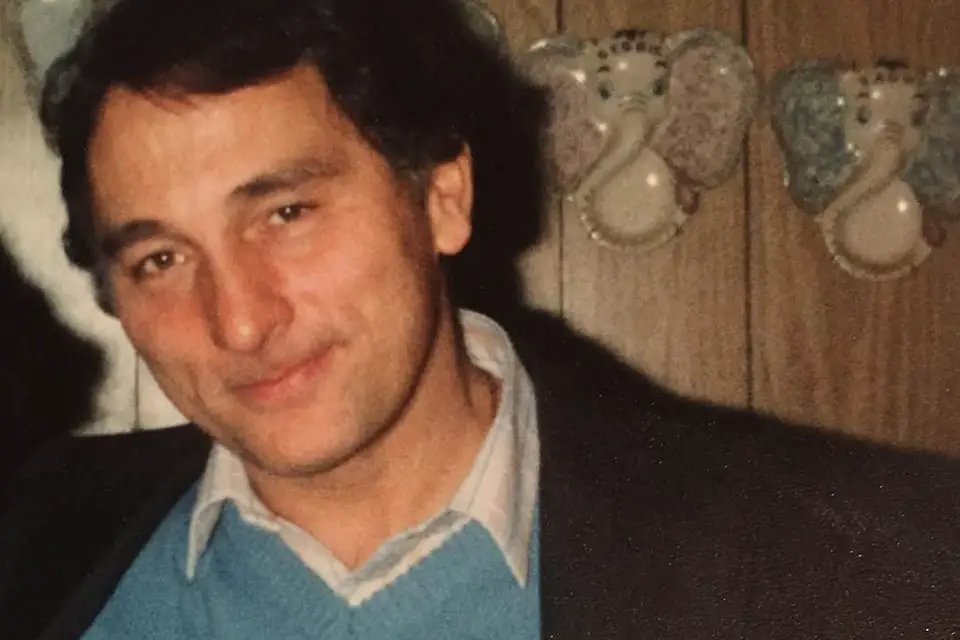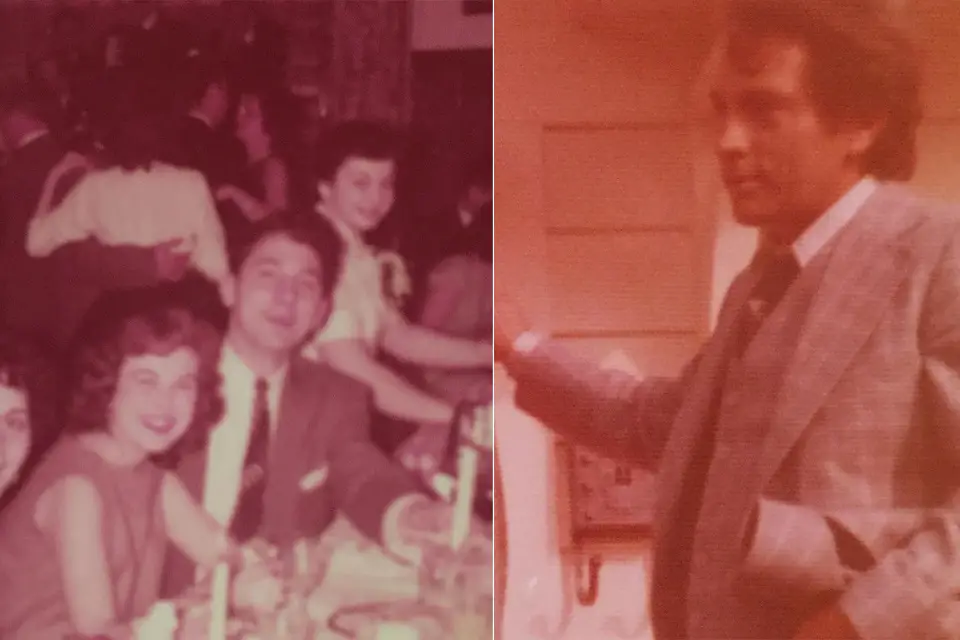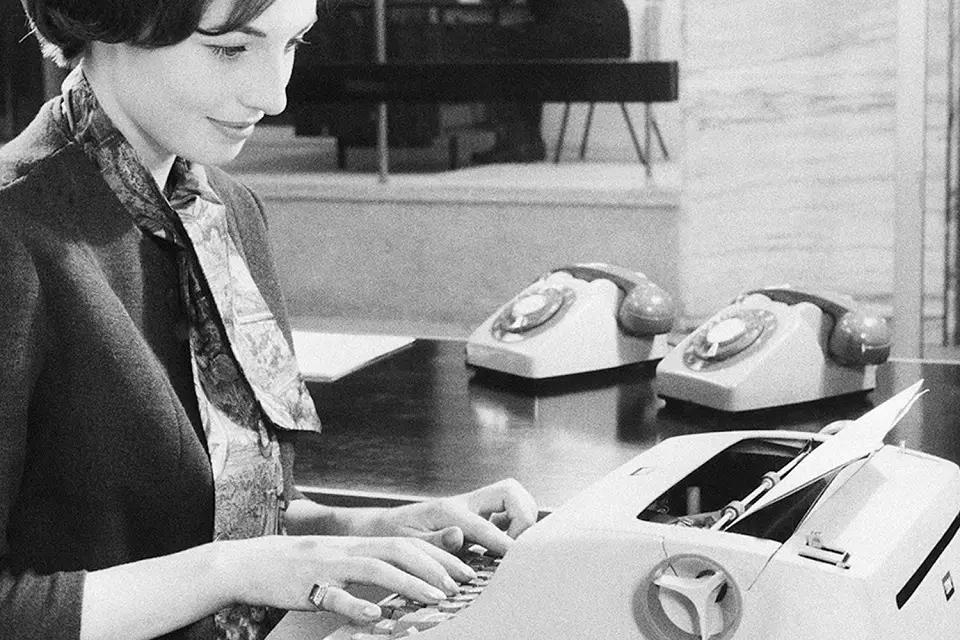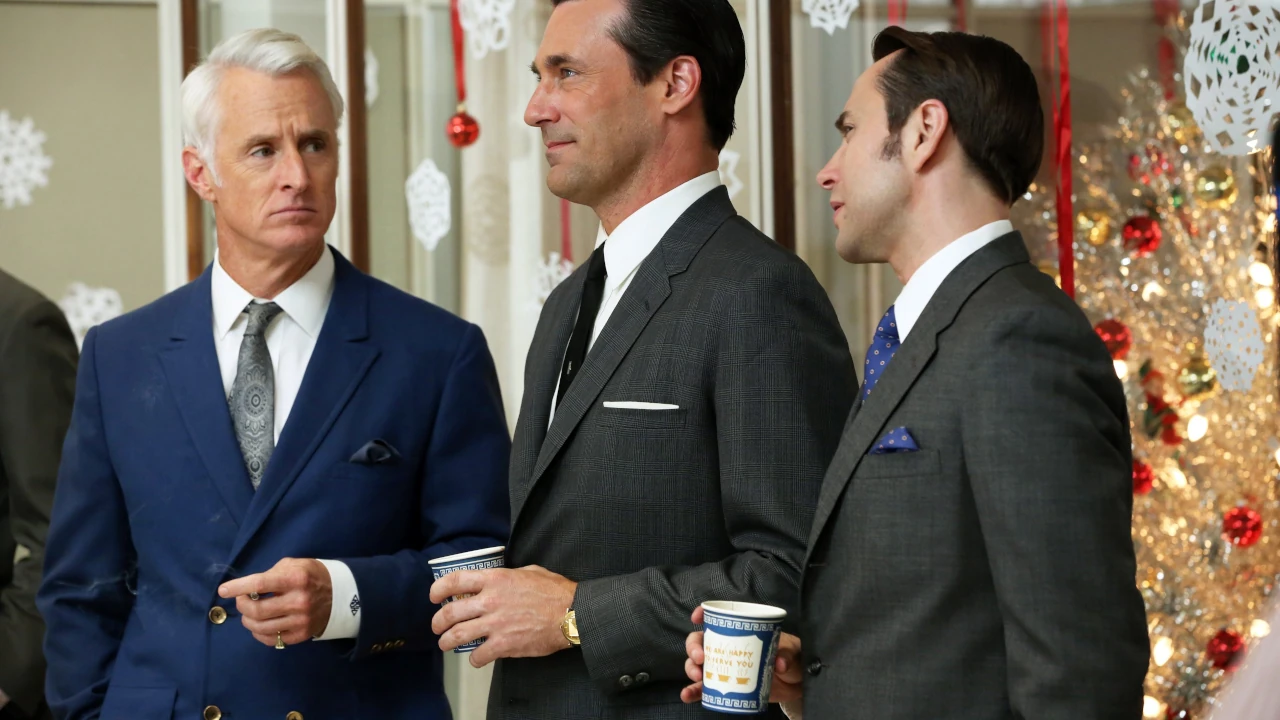It's not a long subway ride from my Upper East Side apartment I share with a college roommate to my office in Midtown Manhattan, but on lazier days, I'll catch an Uber from my iPhone. I swipe in with my key card, take the elevator up to the 19th floor and walk just past the bar carts and beanbag to my desk. Every now and again, whilst sitting here in jeans, reading news about this unusual election, sending people to Mars and spontaneously combusting smartphones, I wonder what this scene would have looked like 50 years ago. Were things really like they appear in Mad Men?
To find out, I asked my 84-year-old grandfather, Frank Schicitano. In 1966, 50 years ago, he was 34, out of the Navy for just over a decade and working as a packaging engineer for Sharp Ivers-Lee Pharmaceuticals in West Caldwell, New Jersey. That's about 25 miles from Madison Avenue. Close enough for me…
Life then, he says, was all about his wife and two daughters, my mom and my aunt—he worked for the family, hung out on weekends with the family and, of course, spent his money on the family.
"We would go out sometimes—not very often, because we had to constantly worry about money," he recalls. "We didn't have anything to fall back on. What we had was what I made and what your grandmother made every week. Weekends were always cooking and eating, cooking and eating… Back then, everything we did was with family. You had money to spend? You spent it on something in the house."
His fondest purchase? A "nice, big pool with a little garden in the back," where he spent weekends with my grandmother, mother, aunt and their teammates on the Red Bank Catholic High School track team. A bit more of a family man than Don Draper, he cherished those relaxing days in the sun.
And he wasn't the only one watching his wallet. Lyndon B. Johnson had just begun his second year in the Oval Office as the country's 36th president, and the economy wasn't ideal—the stock market witnessed a nine-month decline of 25 percent; federal debt was at $328.50 billion; unemployment dipped just barely from the year prior to 4.5 percent and inflation reached 2.7 percent (a stark contrast from the .12 percent rate we saw in 2015 and .82 this year).
But what was actual work like back then? Sure, there were suits and ties and gender inequality like Mad Men, but my grandfather also told me tales of car phones and energy powder and blackmail(!) that I never expected. What follows, then, is a day in the life of a thirty-something white-collar worker five decades ago…

7:30 AM: Rise and shine to the sounds of the Space Age
"Coffee, every morning—as soon as I got up," my grandfather says. "I'd sit down and your grandmother would make oatmeal or something like Wheaties. Occasionally, we'd have eggs and ham if your grandmother had time to make it."
She worked, too, hiring civilian personnel at Fort Monmouth, which was about 10 minutes away.
"I'd get dressed in a suit, shirt and a tie," he adds. "In those days, we didn't have casual Fridays. Even the ladies, they'd always have suits or dresses—nobody ever wore pants or anything like that! The men were always dressed like gentleman businessmen and the women were always dressed like professional office workers. There were no easy days."
The radio station disseminated the weather and morning news in the background. The very first operational weather satellite, ESSA-1 launched in the US, and the Soviet Luna 9 made its first soft landing on the Moon. Lunar Orbiter 1 took the first photograph of Earth from the Moon just a few months later, and the US and USSR signed a treaty to prohibit nuclear weapons in outer space.
"You had a lot of space things that were going on at that time; space travel was just starting, really," he recalls. "And, of course, you always had all the war news—Vietnam."
The Vietnam War was in full swing, with anti-war demonstrations popping up across the US, Europe and Australia. In other words, there was at least as much unrest and discontent with politics then as there is today.

8:30 AM: Butcher Sinatra's lyrics en route to work
"I lived in Long Branch and our office just moved up to West Caldwell, so I didn't leave Ocean Township until probably 8:30 because I would miss all the traffic going north on the Parkway," he explains.
The Parkway at that time cost a quarter—one getting on and one getting off. Today, it's $3 for the same toll. He drove a four-door Chevy, which, in '66, was a boulevard favorite, the Chevy Impala. Engine-builder and drag racer Bill "Grumpy" Jenkins famously took full advantage of the '66 Chevy, putting out 350 horsepower on the drag strips with the factory option 327.
My grandfather would just tune up the radio in his, alternating among a variety of music stations during his hour-long drive north.
"I always listened to Sinatra and Dean Martin," he says. "I loved Diana Ross then, Sarah Vaughan and also Ella Fitzgerald was one of my favorites. Country was a lot of Johnny Cash and Dolly Parton. They all told a story— railroads and bank robbers. I would listen to a lot of country western and classical."
It was a big year for music, really. David Bowie released his first single, "Can't Help Thinking About Me." John Lennon famously said, "We (The Beatles) are more popular than Jesus." The Rolling Stones released "Paint it Black." Frank Sinatra recorded "Strangers in the Night," which later reached #1 on Billboard charts. Simon & Garfunkel's "Sound of Silence" reached #1 on the Billboard Hot 100.
But when my grandfather had too much work to get done, he instead got a head start on dictating three or four letters and handling a couple of work orders from one of the very first car phones.
"When we first had car phones, they looked like your house phone—they were big, clumsy-looking things," he laughs. "After a while, they hooked them up so you could put the speaker up on the visor and you didn't have to hold anything. In my case, I would get a lot of work done on that one-hour trip up because nobody would bother me… I'd talk to my assistant in the office, Michelle. She was great. Without Michelle, I would have been lost. And by the time I got to the office, all of that work would be done"

9:30 AM: Do some work, somehow, without a computer
In my grandfather's sales department, there were eight or nine female secretaries and assistants, and another eight men.
"We had a lot of oriental quality control people, for some reason—I never even thought about it until now," he reminisces about his office staff. (Yes, he said "oriental." He's 84—cut him some slack). "There were two men and about six women in that department. In the accounting area, there were probably six to seven men and another dozen women. All the departments were very similar to a business office now and the departments you'd have today except they didn't have computers."
Nobody had computers, of course. They used typewriters.
"When we first got a computer, it was the size of a house—probably in the early '70s," he recalls. "We had to build an air-conditioned room for it. It was an enormous thing… It was way into the '90s before any of the sales guys or anybody had their own computers."
Of course, without computers, the major headlines of the day didn't circulate as quickly. No one was tweeting out "A Sniper Atop the Tower at the University of Texas Kills 12 and Wounds 31" or "Artificial Pump is Implanted in Heart."

12:30 PM: Enjoy a mostly scandal-free lunch break
For better or worse, office culture in the mid-'60s was not as debaucherous as Mad Men would have us believe. Drinking at one's desk was unheard of and smoking in the office was strictly prohibited—at least where my grandfather worked at Sharp Ivers-Lee Pharmaceuticals.
"We had a vice president who was a lush," he says matter-of-factly. "He'd go out for lunchtime and come back totally wacked. He was part of the ownership so nobody was ever going to say anything to him, and he would have two or three drinks at lunchtime… And now that you mention it, there was one guy, Jack Creighton, who, at lunchtime, would have a drink."
Back then, the go-to was Scotch, particularly Dewar's White Label and, shortly thereafter, Johnnie Walker Black Label. At the time, ads for Dewar's White Label depicted an Edinburgh castle that read, "Dewar's never varies!" Cigarette ads also began to catch peoples' eyes. Beginning in '66, all US cigarette packages had been required to state, "Caution: Cigarette smoking may be hazardous to your health."
He told me a story about this Jack Creighton, as he remembered him.
"Because [that vice president] was such an obnoxious guy, Jack Creighton and I would go to this Holiday Inn and we brought him along one time because we knew that, in this Holiday Inn, there was a girl—let's say she was a hooker," he says. "We arranged for this young lady to perform some oral sex on this vice president. So, therefore, he could never ever tell us anything because we knew that. I shouldn't even say that. But we did this because it was the thing to do because he was such a prick that we were going to get him one way or another! He was in our back pockets forever after that, until we left…"
Of course, my grandfather admits this was worse than conniving, but he says that sometimes you have to do some strange things to get by in the workplace.
"There are some good people in this world, and there are some bad people in this world," he observes. "And the bad people deserve to get their asses kicked."
Scandals like this one were not as common as in Mad Men. That said, office affairs did happen, though most men were faithful family guys, my grandfather insists.
"If one guy was screwing one of the secretaries down the hall, nobody else knew about it," he says. "One vice president would chase half of the broads—half of the girls—in the place. He was chasing one of the secretaries and I happened to know that because she would come to me and say, Frank, what can I do? She would come crying to me all the time that this guy was on her ass all the time, all the time… After a while he'd come and see me and say, Come on, Frank, I'll take this one and you take that one and we'll have a drink. Oh yeah, sure, mhmm."

3:30 PM: Get back to being a goddamn boss
My grandfather worked in a time that, not unlike now, valued initiative and creativity. He developed something different every few months in the pharmaceuticals industry—from packaging to the products themselves.
"I would develop the packages for pharmaceuticals, but there were times when I would develop the whole thing, too," he explains. "If I was working with a couple of guys down south in Louisiana who had an idea on something that they could sell in the 7-Eleven stores or something, I would develop the product, the package that it went in, the boxes and the cartons and the whole thing."
He worked on everything from the very first gas station games—long before scratch-offs—to a drink mix called "Morning After," which was sold in 7-Eleven stores across the country.
"Morning After was a powdery drink that guys could drink after they were drunk at night," he explains. "And, no, I didn't have anything to do with the birth control pills! It was like an Alka-Seltzer with lemon flavor."
He was also responsible for making some of the country's first promotional samples and magazine inserts for companies like Revlon, Johnson & Johnson and Max Factor.
"The customers, the clients, would leave it up to me to think of something that they could use to advertise their product," he says. "That gave me the opportunity to fly around the country. So I had a chance to go around the country with these strange ideas."
Traveling for work was a bigger privilege at the time, as many people didn't have the opportunity to see as much of the country. Most of what they knew about other places came from movies.
"One time, I met two ladies at the bar and when I told them my name, Frank Schicitano, they said, are you an Eye-talian from New Jersey?" he remembers. "They wanted to know if I ever killed anybody in the Mafia. That's what they'd seen in the movies and that's what they believed! Movies influenced a lot of people in what they thought the world on the other side of the river was like."
For reference, some of the top movies of 1966 included: They're a Weird Mob, Alfie, The Russians are Coming, the Russians are Coming (how foreboding) and Our Man Flint.

5:30 PM: Spend quality time with the family, remember why you work in the first place
Traffic was no joke, especially for those living in the New Jersey-New York area. One of the biggest NYC transit strikes in history took place for two weeks in the dead of winter in '66, and the US airline strike went on for over a month from July 8th through August 19th.
Commuting became a struggle for everyone, so leaving the office even before 5:00 PM was not uncommon.
"I'd leave to beat the traffic on the Parkway," he says. "When I got home, your grandmother would cook… I wouldn't really go to bars then—not during that time. It really was all about family."
After dinner, most families spent time together unwinding. NBC launched the first-ever entire lineup televised in color and, just before Christmas on December 18th, Dr. Seuss' How the Grinch Stole Christmas aired for the first time on CBS.
"Then we'd be off to bed and be up early for the next day," my grandfather says.
Flash forward and, today, I spend Christmas mornings with my grandfather and big Eye-talian family still watching Dr. Seuss' How the Grinch Stole Christmas—I guess some things never change. (Except we're not eating Wheaties; we're eating some bomb French toast).
Now, I'm sure I didn't ask every possible question, and I'm sure my grandfather left out a detail or two here and there, but it's nice to have a little perspective whenever, say, I can't decide which pair of jeans to wear to work or my laptop battery dies or Twitter is on the fritz. After all, it's not like I have to use a Holiday Inn and a hooker to blackmail some jerk in the office to keep him off my back or anything. Ah, those were the days.
 CRIME Shirt $21.68 |
 |
 CRIME Shirt $21.68 |

